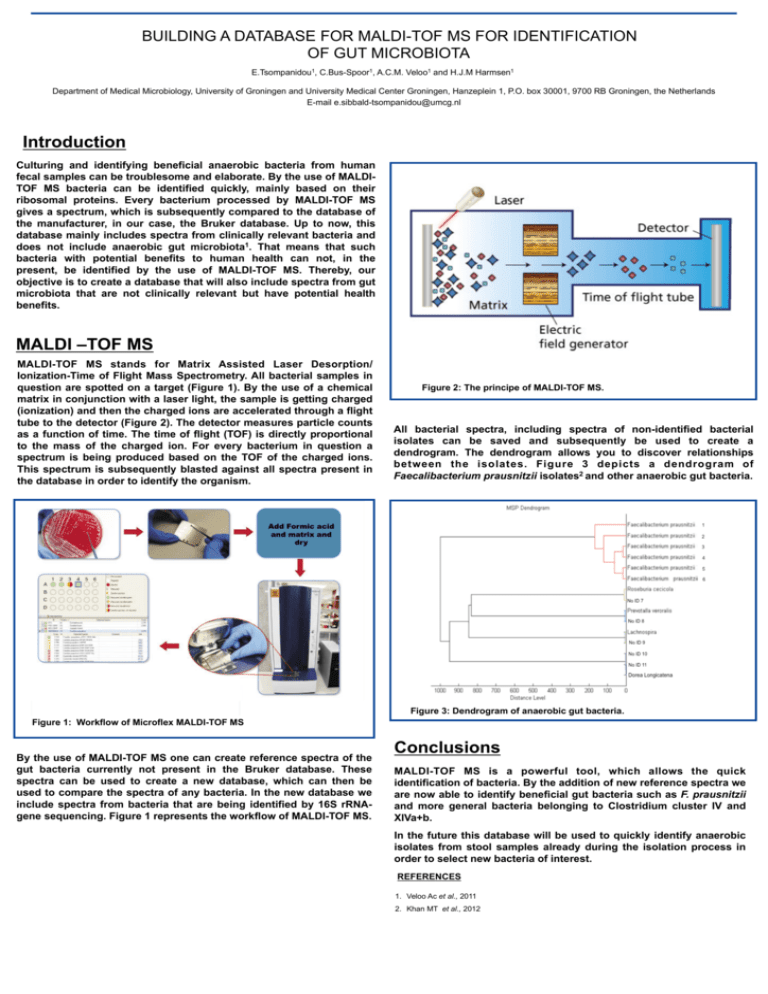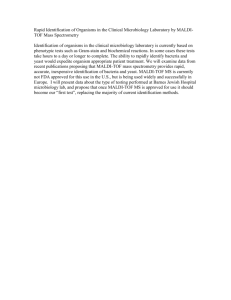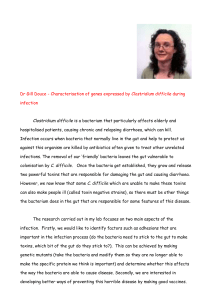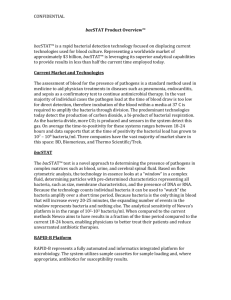Introduction MALDI –TOF MS Conclusions
advertisement

BUILDING A DATABASE FOR MALDI-TOF MS FOR IDENTIFICATION OF GUT MICROBIOTA E.Tsompanidou1, C.Bus-Spoor1, A.C.M. Veloo1 and H.J.M Harmsen1 Department of Medical Microbiology, University of Groningen and University Medical Center Groningen, Hanzeplein 1, P.O. box 30001, 9700 RB Groningen, the Netherlands E-mail e.sibbald-tsompanidou@umcg.nl Introduction Culturing and identifying beneficial anaerobic bacteria from human fecal samples can be troublesome and elaborate. By the use of MALDITOF MS bacteria can be identified quickly, mainly based on their ribosomal proteins. Every bacterium processed by MALDI-TOF MS gives a spectrum, which is subsequently compared to the database of the manufacturer, in our case, the Bruker database. Up to now, this database mainly includes spectra from clinically relevant bacteria and does not include anaerobic gut microbiota1. That means that such bacteria with potential benefits to human health can not, in the present, be identified by the use of MALDI-TOF MS. Thereby, our objective is to create a database that will also include spectra from gut microbiota that are not clinically relevant but have potential health benefits. MALDI –TOF MS MALDI-TOF MS stands for Matrix Assisted Laser Desorption/ Ionization-Time of Flight Mass Spectrometry. All bacterial samples in question are spotted on a target (Figure 1). By the use of a chemical matrix in conjunction with a laser light, the sample is getting charged (ionization) and then the charged ions are accelerated through a flight tube to the detector (Figure 2). The detector measures particle counts as a function of time. The time of flight (TOF) is directly proportional to the mass of the charged ion. For every bacterium in question a spectrum is being produced based on the TOF of the charged ions. This spectrum is subsequently blasted against all spectra present in the database in order to identify the organism. Figure 2: The principe of MALDI-TOF MS. All bacterial spectra, including spectra of non-identified bacterial isolates can be saved and subsequently be used to create a dendrogram. The dendrogram allows you to discover relationships between the isolates. Figure 3 depicts a dendrogram of Faecalibacterium prausnitzii isolates2 and other anaerobic gut bacteria. Figure 3: Dendrogram of anaerobic gut bacteria. Figure 1: Workflow of Microflex MALDI-TOF MS By the use of MALDI-TOF MS one can create reference spectra of the gut bacteria currently not present in the Bruker database. These spectra can be used to create a new database, which can then be used to compare the spectra of any bacteria. In the new database we include spectra from bacteria that are being identified by 16S rRNAgene sequencing. Figure 1 represents the workflow of MALDI-TOF MS. Conclusions MALDI-TOF MS is a powerful tool, which allows the quick identification of bacteria. By the addition of new reference spectra we are now able to identify beneficial gut bacteria such as F. prausnitzii and more general bacteria belonging to Clostridium cluster IV and XIVa+b. In the future this database will be used to quickly identify anaerobic isolates from stool samples already during the isolation process in order to select new bacteria of interest. REFERENCES 1. Veloo Ac et al., 2011 2. Khan MT et al., 2012







